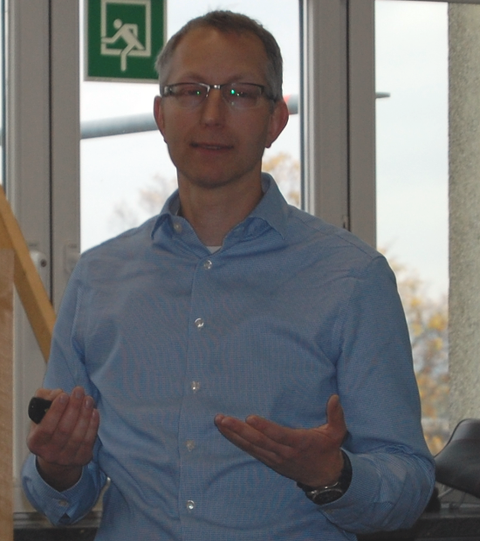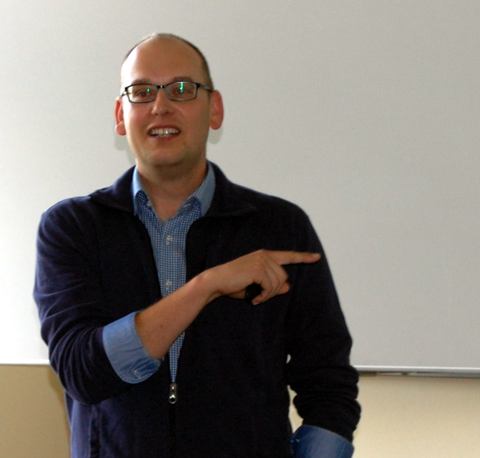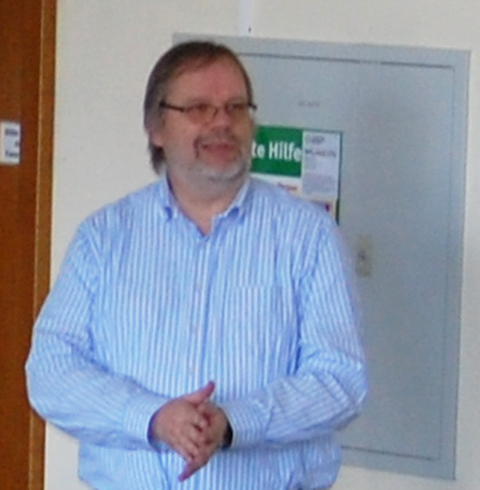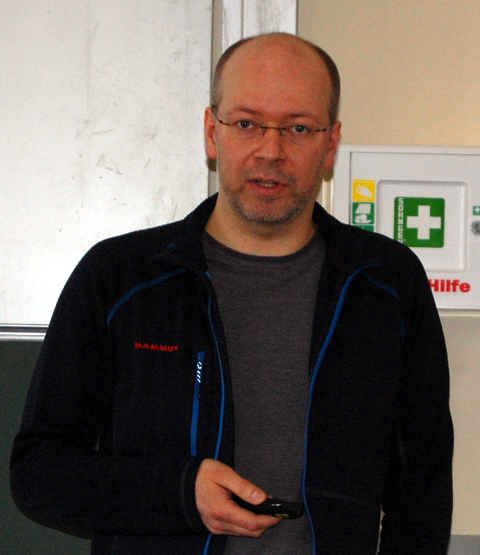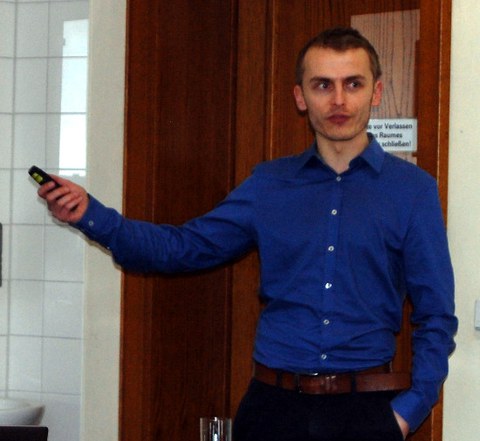ZIH-Colloquia 2018
The ZIH colloquium is a public event and takes place on each 4th Thursday of the month at 15:00 o'clock in the room Willers-Bau A 317.
For additional or extraordinary events time and room are explicitly mentioned.
Additional colloquium: 17. December 2018, 13:00, APB 1004: Thomas Eifert (RWTH Aachen, IT Center) „Datensicherung im Wandel“ (slides)
Der Umgang mit Daten und Datenhaltung insgesamt sind einem starken Wandel unterworfen, nicht zuletzt durch das geänderte Bewusstsein für Daten, das mit der Einführung von Forschungsdaten-Management einhergeht. Die Konsequenzen für Datensicherung und geänderte Ansätze zur Sicherung von Daten sind Gegenstand dieses Vortrags.
Additional colloquium: 12. December 2018, 11:30, APB 1096: Enrico Gavagnin (University of Bath) „The invasion speed of cell migration models with realistic cell cycle time distributions“
Cell proliferation is typically incorporated into stochastic mathematical models of cell migration by assuming that cell divisions occur after an exponentially distributed waiting time. Experimental observations, however, show that this assumption is often far from the real cell cycle time distribution (CCTD). In this talk I will investigate the connection between the CCTD and the speed of the collective cell invasion. I will present a series of stochastic and deterministic age-structured models which can be used to explore this connection from an analytical perspective. The results allow us to determine the range of possible invasion speeds in terms of the average cell proliferation time. Finally, I will discuss potential medical applications of these models to melanoma drug treatment optimisation and other extensions.
Additional colloquium: 5. November 2018, 15:00, Andreas-Pfitzmann-Bau room 1096: Till Bretschneider (University of Warwick) "Image-based modelling of problems in cell motility"
Mathematical modelling has been key to understanding the mechanics of cell shapes and theoretical principles behind the complex spatio-temporal biochemical regulation of directed cell motility. Although live cell fluorescence microscopy allows to visualise cellular dynamics in great detail, most models are phenomenological in nature, because extracting quantitative data from time series images of moving cells is challenging. We have been developing image analysis software (QuimP, Baniukiewicz et al., 2018) to map cell shape changes and fluorescence distributions of cytoskeletal proteins in the actin cortex of Dictyostelium cells. I am going to present work on fitting experimental data obtained by QuimP to mathematical models of 1) cells undergoing reorientation in response to alternating gradients of hydrodynamic shear flow (Lockley et al., 2015) and 2) blebbing in cells moving under a sheet of agarose (Collier et al., 2017). Here, a main result is that cell geometry (negative curvature) plays a previously under-appreciated role in determining where cells bleb. This will be followed by an outlook on challenges arising from 3D imaging of single cells obtained using light sheet microscopy (diSPIM and lattice light sheet), and GPU based approaches for image segmentation. Deep convolutional neural networks for creating synthetic 3D images of cells with protein distributions learned from experimental data are turning out to be a novel, useful tool for validating different segmentation routines.
25. October 2018: Alf Gerisch (TH Darmstadt) "Attraction and Repulsion in Biological Tissues: Challenges for Mathematical Models, Analysis, and Numerics" (slides)
Cell attraction and repulsion are essential processes in biological tissues. Cellular adhesion, in particular, plays a key role during embryonic development and in the invasion of healthy tissues by tumour cells. In this talk, after an introduction to the biological motivation, I present a non-local partial differential equation model of attraction and repulsion which goes back to work by Armstrong, Painter, and Sherratt (2006). This is followed by a recent derivation of this model from an individual-based model, an overview of analytical results, and an identification of numerical challenges with respect to the treatment of nonlocal terms and their resolution. Finally, I will give a glance on current work regarding adhesion on growing domains.
Alf Gerisch is a researcher in the Numerical Analysis and Scientific Computing group at Technische Universität Darmstadt. He received his Master's degree in Mathematics from the University of Dundee (Scotland, UK) and his doctoral degree (Dr. rer. nat.) from Martin-Luther-Universität Halle-Wittenberg. His research is focussed on providing numerical and computational tools for problems from mathematical biology. This includes multiscale models and homogenization techniques for elastic properties of hard tissues and accurate and efficient schemes for the time-dependent simulation of different processes in soft tissues.
Additional colloquium: 11. October 2018, 10 Uhr: Jens Domke (Tokyo Institute of Technology) "Exploring alternative Designs for HPC Interconnects and HPC Processors"
This talk will disseminate the current status and lessons-learned of two work-in-progress HPC projects conducted at the Tokyo Institute of Technology. For the first part, we will introduce our HyperX topology project. The HyperX topology was proposed by HP Labs in 2009. This topology is based on an n-dimensional mesh network with additional links added to the base topology (which only connects to the nearest neighbors in each dimension) to connect to all other switches within each dimension. HyperX should perform similar to a Clos network (a.k.a fat-tree) with respect to bisection bandwidth and other related network metrics, while reducing the costs to build an equally sized supercomputer. However, as of today, no large-scale HPC installation uses this type of network topology. We, at Tokyo Tech, are in the process of building the first multi-Petaflop/s HyperX supercomputer from the remains of the TSUBAME2 system which got replaced by T3 recently. The resulting system will allow us a direct and real-world comparison between a fat-tree and a HyperX topology. The second part of the talk will cover our current efforts to analyze the bottlenecks in modern CPU architectures, specifically the Intel Xeon Phi family. Common wisdom in supercomputing, also partially driven by the Top500 list, is that double precision floating point calculations is what matters, with respect to both application requirements and performance. Accordingly, chip vendors for HPC compute nodes have traditionally allocated a significant portion of chip area to double precision FPUs. We conducted an exhaustive FPU-requirement and performance study using 22 HPC (proxy/mini) applications from various scientific domains, which comprise the majority of CPU cycles in HPC, and which all have been used in the USA and Japan to procure the current generation of supercomputers, such as Summit and Post-K. This study will give us and the rest of the community a valuable insight into the precision or unit requirements, and identified performance bottlenecks in modern HPC codes, to guide the procurement towards more/less FP64, FP32, ..., or faster/bigger memory and caches, or more cores instead.
Jens Domke is a postdoctoral researcher at the GSIC, which hosts the TSUBAME3 supercomputer for the Tokyo Institute of Technology, Japan. He received his doctoral degree from the Technische Universität Dresden in 2017 for his work on HPC routing algorithms and interconnects. Jens contributed the DFSSSP and Nue routing algorithms to the subnet manager of InfiniBand. His research focus is on interconnects, topologies, and
routing algorithms for HPC systems, as well as performance evaluation and optimization of parallel applications.
Additional colloquium: 13. July 2018, 15 Uhr, Großer Ratssaal, APB, Nöthnitzer Str. 46: Philip Maini (Wolfson Centre for Mathematical Biology, Oxford, Fellow of the Royal Society) "Modelling Collective Cell Motion in Biology and Medicine"
Collective cell motion is a common phenomenon in biology - both in normal development and in disease. I will review work that we have been doing on examples in both cases. I will show how, working with experimental colleagues, we have been able to advance knowledge in the biological understanding of cranial neural crest cell invasion, using a hybrid agent-based model. I will then consider the well-known snail-trail model in angiogenesis and show that a systematic derivation starting from a cell-level master equation leads to a coupled system of partial differential equations that are quite different to those in the literature.
Philip K. Maini FRS FMedSci is Director of the Wolfson Centre for Mathematical Biology, Mathematical Institute, Oxford, and Statutory Professor of Mathematical Biology. He was awarded the LMS Naylor Prize in 2009 and the SMB Winfree Prize in 2017.
24. Mai 2018: Janis Keuper (Fraunhofer-Institut für Techno- und Wirtschaftsmathematik) "Towards scalable Machine Learning" (slides)
This talk will discuss the challenges and recent progress towards the application of machine learning methods to very large and difficult learning problems. We will analyse, why building a scalable high performance learning system is such a difficult task and which theoretical and practical problems need to be solved a every level of a Machnie Learning System - from accelerator hardware designs, over HPC system IO and communication protocols up to software middle layers, mathematical foundations and distributed learning algorithms.
Janis Keuper leads the "Large Scale Machnine Learning" group at the Fraunhofer Competence Center for High Performance Computing and is a Principal Investigator at the Fraunhofer Center Machine Learning. His current research is focus on scalable machine learning systems, especially Deep Learning. Before joining ITWM in 2012, he was a Group Leader at the Intel Visual Computing Institute (Saarbrücken, Germany). Janis received his Masters and PhD degrees in Computer Science form the Albert-Ludwigs University in Freiburg and did his PostDoc training in the group of Prof. Bernd Jähne at the University of Heidelberg. Janis is the chair of the Deep Learning trac at the ISC Supercomputing 2018 conference and member of the organizing committee of the "Machine Learning in HPC" Workshop at the ACM Supercomputing 18 conference. Publications: https://scholar.google.de/citations?hl=de&user=BUkDvU0AAAAJ&view_op=list_works
26. April 2018: Attention - different time 12:00 - Thomas Steinke (Zuse Institut Berlin) "Application Performance on Many-Core Platforms" (slides)
We will give an overview of research projects of our department and present recent results of our activities within the Intel Parallel Computing Center (IPCC) at ZIB and related projects. The overall theme is our interest to achieve optimal applications performance on HPC platforms. We discuss the associated challenges to achieve an efficient use of the compute resources and our approaches for improving the performance of scientific workloads.
Thomas Steinke heads the Supercomputing dept. at ZIB. He received his Doctorate in 1990 from the Humboldt-Universität zu Berlin working in the field of theoretical chemistry. His research interest is in HPC, heterogeneous systems, and state-of-the-art simulation methods. Thomas leads the IPCC at ZIB since 2013 and was co-founder of OpenFPGA in 2004.
29. March 2018: Carsten Weinhold (TU Dresden, Professur für Betriebssysteme) "FFMK: A Fast and Fault-tolerant Microkernel-based Operating System for Exascale Computing" (slides)
The FFMK project designs, builds, and evaluates a system-software architecture to address the challenges expected for Exascale systems. These include runtime variability within applications, hardware performance variation, and operating system noise. Our operating system combines a small L4 microkernel to provide a low-noise execution environment and a full-blown general purpose operating system (Linux) for compatibility with existing HPC codes. The architecture is complemented by decentralized system management and checkpointing components. The talk will give an overview of the project, research done by the individual partners (including TU Dresden's operating systems group and ZIH), and how HPC systems at ZIH are used in the project, ranging from studying application behavior all the way down to bare-metal runs of an experimental operating system on Atlas and Taurus nodes."
Dr.-Ing. Carsten Weinhold is a member of the operating systems group at TU Dresden. His research started in microkernel-based operating systems and security architectures. In 2014, he defended his doctoral thesis on re-architecting a file system stack so as to isolate and better protect its security-critical functionality. He now applies the underlying idea of split code bases to HPC to ensure performance isolation and to reduce latency.
22. February 2018: Linus Schumacher (Biological Physics, Imperial College London) "Collective feeding in worms: Quantitative phenotyping and modelling identifies behavioral rules underlying aggregation in C. elegans"
Collective behaviour is a hallmark of complex living systems. Often studied in groups of large animals or small cells, it less well understood at the mesoscopic scale. We investigate collective feeding of the nematode C. elegans, known for its easy genetic manipulation and stereotypic, yet complex behaviour. In this system, small genetic perturbations can lead to strikingly different population-level behaviours. We quantify behavioural differences between the „solitary“ lab strain and a „social“ aggregating mutant. To understand the mechanism of aggregation, we draw on concepts from motility-induced phase transitions and agent-based modelling. Finally, we investigate the potential benefits of collective feeding in an attempt to explain the predominance of aggregating strains in the wild.
Short CV:
Ba & Msci in Natural Sciences, Cambridge
PhD with Ruth Baker and Philip Maini in Mathematical Biology, Oxford
Thesis on mathematical models of collective cell migration in developmental biology
Currently postdoc in Biological Physics and Imperial College London, working with Robert Endres and Andre Brown
This summer starting Chancellor’s Fellowship at University of Edinburgh
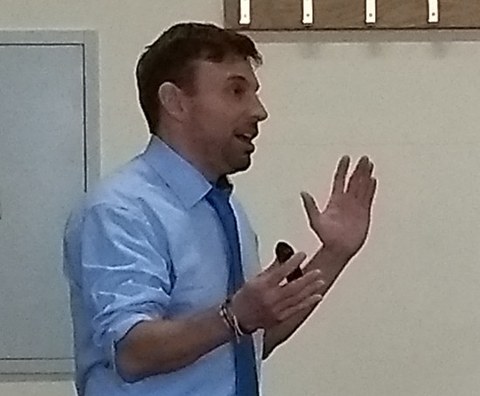
Philip Mucci
25. Januar 2018: Philip Mucci (University of Tennessee) "An Evolution of the Data Center"
This talk is intended to be an entertaining and thought-provoking look into the future of the data center. Whether running on premise or in the cloud, increases in both scale and complexity negatively affect productivity and return on investment. The availability and affordability of expertise continues to decrease. Technology adoption cycles are shrinking while the numbers of users and service platforms are growing. Roles and responsibilities have remained largely unchanged since the 1970’s, as have reporting and accounting procedures. While the technology has evolved, our collective ability to maximize data center assets has not. In this talk, we will explore how one might sustainably mitigate these factors with software design. In doing so, we will draw lessons from process management, business intelligence, data analytics, machine learning, continuous integration and human behavior and applying them to specific roles. Our ultimate goal being a data center operation that is perfectly incentivized; with technology-enabled personnel driving year over year increases in productivity and return on investment.
Philip is best known as the inventor of the Performance Application Programming Interface (PAPI), an application-centric, performance monitoring middleware, in use globally since late 1990’s. He has held varied roles in industry, including director of engineering, software architect, business developer, strategic advisor. He is the founder of Minimal Metrics, a technology and strategy provider for highly efficient systems. In addition to being an active board member for a number of organizations, he holds a part-time research position at the University of Tennessee under Dr. Jack Dongarra.
past years
History 2017
History 2016
History 2014/2015
History 2013
History 2012
History 2011
History 2010
History 2009
History 2008
History 1998 - 2007


